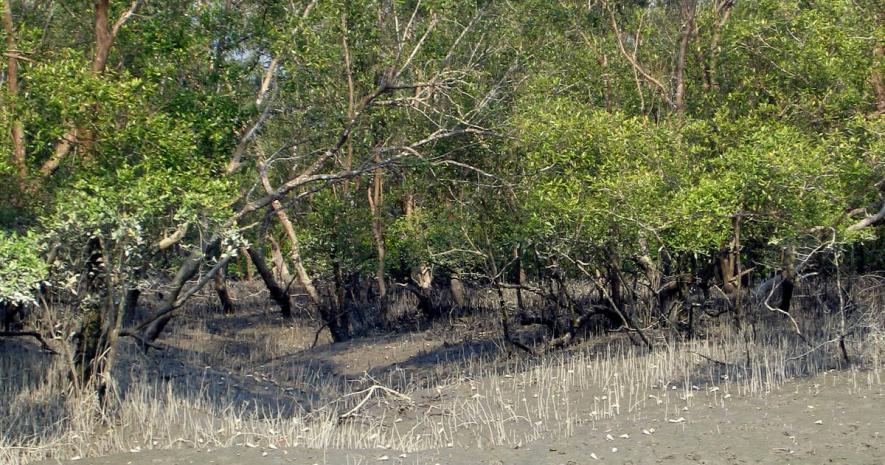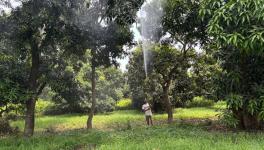Global Warming: India as Much at Risk as Pacific Islanders

Image Courtesy: UNESCO
In the popular imagination, Sunderbans is an exotic terrain. It instantly evokes images of tigers and mangroves. But this archipelago of islands, straddling India and Bangladesh, is also home to millions of the most vulnerable and impoverished people on earth; people who are affected by one of the most dramatic examples of rising sea levels in recent years. Many islands have got washed away. The sea continues to rise. Unlike residents of islands in the Pacific, whose plight draws global attention, the lives of the people of Sunderbans do not typically figure at international climate negotiations.
The stories of loss, longing and resilience in these parts, however, are no less important.
Reshma Khatoon is unaware of international climate negotiations or what they could mean to people like her. She tells me she played Ludo with her sisters-in-law through the night, as they waited to see if the Bay of Bengal would invade their seventh home. Rising due to climate change, the sea has already destroyed their home in Ganga Sagar Island six times. Each time, her family built anew, this time in cement and brick. They were lucky this time, though no one in their home—like many residents of the island—slept. The crash of thunder woke everybody at around 2 a.m on August 17. The brightness of the lightning and proximity of the thunder had them cowering for about an hour; then the rain came pelting down.
Reshma, a bubbly 20-year-old final year student of English Honours at Sagar College, clad in a bright pink salwar kameez, has been only once to Ghoramara, the island near Ganga Sagar that has lost more than half its land to the rising sea and from which her family was displaced 30 years ago. She loved the walk along the Muri Ganga river—a distributary of the Ganga — but the sight of soil undercut by water and continuously sliding into the estuary frightened her.
Till the West Bengal government built a lock-gate at the mouth of a local river five years ago, Reshma’s home in the Jibantala Manasa Dwip area of Ganga Sagar—where India’s national river meets the Bay of Bengal—was also flooded regularly, apart from the six times it was washed away. This is why the family was on alert through that stormy August 17 night. They knew they may have to flee again. Reshma knows her way to the storm shelter—set up in the local primary school—luckily she did not have to go there this time.
Playing Ludo while you wait to be flooded out, displays mental resilience of a high order to climate change impacts. Yet, this is not what Reshma or other residents of Ganga Sagar Island deserve. These farming and fishing families have hardly any carbon footprint of their own. Still they have been displaced so often by the rising sea that many prefer to leave altogether. They take up work as fishing boat crew in Gujarat, masons in Kerala, waiters in Bengaluru restaurants, gardeners in Gurugram, house help in Kolkata—just about anything to get away from the disappearing island. In many homes, menfolk migrate to return once or twice a year. They send money home but leave wives and mothers to negotiate a crumbling world.
Visiting Sagar island reminded this writer of the stories about the drowning island nations in the Pacific and the Caribbean. For the people of Kiribati—a Pacific archipelago whose average elevation is less than 2 metres above the sea, it is literally an existential crisis. Large parts of the country could be underwater by 2050. At the global climate summit in Poland last December, small states most vulnerable to climate change made the loudest calls for quick action on carbon emissions, The Washington Post reports. Leaders of several small island nations such as Kiribati reminded the delegates from powerful nations that their countries could be swallowed by rising seas too, if climate change is not checked.
But where is the voice of people of Sundarbans in global climate talks? Is enough being done to draw the world’s attention to the impact of climate change on this low-lying area? The 4.5 million people who live in just the Indian part of the Sundarbans face the same hazards as the Pacific islanders. But contradictory pulls and pushes on the Indian climate negotiators by various ministries ensure that they do not push the case of the people of the Sunderbans or any other vulnerable region with any vigour at the annual United Nations summits.
That successive governments have done too little and too late for the impoverished people in these islands is clear to any visitor. The West Bengal government has a State Action Plan on Climate Change but a lot more needs to be done on the ground.
Reshma’s elder brother, Mofissul Islam, says their family got 0.4 hectares of farmland as compensation in Ganga Sagar Island when the family was displaced from Ghoramara, but they still haven’t got the title deed to it though 30 years have gone by. The same goes for the 300-odd Ghoramara families who were resettled in the neighbourhood.
Located at the south-western edge of the Sundarbans and the mouth of the Ganga’s main western distributary, the Hooghly, Ganga Sagar is India’s second-largest riverine island. This is where many of the drowned-out residents of the Sundarbans have been resettled. As Ganga Sagar keeps losing land to the sea, they have to keep moving towards the crowded centre of the island. They know that they may have to leave the island altogether. All around the edges of their island, the once fertile soil has turned too saline for paddy, their traditional crop. The water from deep tube wells still comes up fresh, but the quantity is too low for anything other than drinking and cooking. The surface water is too saline for irrigation.
With the monsoon rains delayed in southern Bengal this year, the storm in the early hours of August 17 brought farmers to the fields to transplant the paddy seedlings, around two months late.
It also brought Sona Mandal of Beguakhali to the seashore. The 47-year-old heads her household as her husband works in Hyderabad. She knows that she can make some extra money by catching shrimp fry brought in by the storm and selling it to shrimp farms—never mind that this is banned. The irony of casting her shrimp net behind a broken sea wall that had been built to protect her home appears to escape her.
Another sea wall is on the mind of Bankim Chandra Hazra, the Member of Legislative Assembly (MLA) who represents the area and also chairs the Ganga Sagar Bakkhali Development Authority. He knows that the national importance of Ganga Sagar Island is due to the annual pilgrimage to the Kapil Muni temple, which is the largest Hindu congregation after the Kumbh Mela. He also knows that this at least the fourth Kapil Muni temple built (local legend says it is the seventh) after the earlier ones were drowned by the sea.
When the current temple was built in the 1970s, it was 800 metres from the high tide line. Now the sea laps its steps every high tide. The West Bengal government is readying to build a sea wall to protect the temple—though Hazra knows sea walls have failed elsewhere, he sees no other option.
And what is the MLA from Trinamool Congress doing for the residents who are losing their farms and are in constant danger of losing their homes? All of them are resettled and compensated, he claims, and adds that there is little more he can do except raise the issue repeatedly in the Assembly.
One will always remember the stories of resilience – like that of 20-year-old Reshma playing Ludo as lightning struck her island. But should not the state and Central governments do more? It is time we hear their voices in international meets about climate justice. Hopefully, it is not too late.
Patralekha Chatterjee is a freelance journalist based in Delhi. She visited Sagar Island on the invitation of Internews’ Earth Journalism Network’s Bay of Bengal Climate Resiliency Initiative to report on climate justice and resilience issues, especially related to coastal women.
Get the latest reports & analysis with people's perspective on Protests, movements & deep analytical videos, discussions of the current affairs in your Telegram app. Subscribe to NewsClick's Telegram channel & get Real-Time updates on stories, as they get published on our website.
























